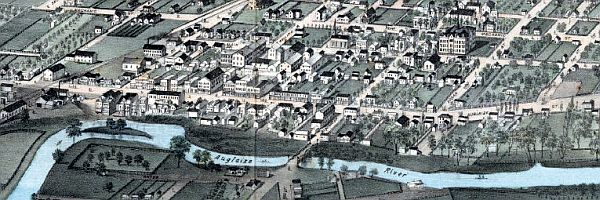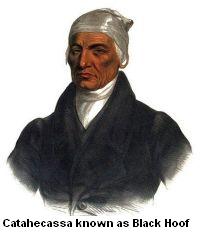
Prehistoric Auglaize County
Bones of Mastodons were located three times in Auglaize County before 1880. The first skeleton was discovered in the fall of 1870 in Clay Township, 2 1/2 miles east of St. Johns while laborers were excavating a ditch through the Muchinippi swamp. The swamp’s depth at this point was about eight feet, the upper third of peat moss, and the lower two thirds of marly clay. The bones were in a posture that indicated the mastodon was sinking in the swampy mire, the head and tusks were reaching upward and the right forefoot thrown forward as if to climb out of a hole. The body was estimated to be 19 1/2 feet long from where the tusks entered the cranium to the base of the tail, the length of the tusks were 12 feet, and its height was estimated to be 13 or 14 feet. In December, 1874, also in Clay Township, the partial skeleton of a larger Mastodon was found by another team of ditch diggers. A third Mastodon was found by Mr. Samuel Craig in January, 1878, while surveying in Washington Township.
Indian Tribes
Originally the land now comprising Auglaize County was claimed principally by the Miami Tribe of Indians, although hunting parties of the Wyandotte tribe would sometimes encroach upon the lands. However, when the Miami village of Pickawillamy (near Springfield, Ohio) was attacked by General George Rogers Clark and completely destroyed by fire in 1782, the tribe moved to the state of Indiana.
Almost as soon as the Miami tribe had moved, the strong Shawnee tribe, which had been driven from the Carolina’s and Georgia, moved in and possessed the land formerly occupied by the Miamis. Under the leadership of Chief Blue Jacket and Chief Black Hoof they established themselves at the mouth of the Auglaize River and built the famous Council House at the present site of Wapakoneta, Ohio. At this new location munitions of war were regularly supplied to them by the British from Detroit and Canada.

Here at the Council House in the village of Wapakoneta, were to be assembled some of the greatest chieftans of Indian lore: Blue Jacket (Weyapiersenwah), his son, James Blue Jacket, Black Hoof (Catahecassa), Tecumseh, The Prophet, Peter Cornstalk, The Little Turtle, The Little Snake, Captain Logan, and others. However, after the Treaty of Greenville, segments of the tribe started to migrate to Missouri. The final migration according to treaty was accomplished in 1832 when James Blue Jacket, who had enjoyed a flourishing trade in liquor, moved out with the last contingent.
The land roughly comprising present Duchouquet Township in Auglaize County was once the Indian settlement which housed the Council House of the various tribes of Indians that lived in the Northwest Territory. The township was named for Francis Duchouquet, the French fur trapper and noted Indian interpreter who lived with the Shawnee at Wapakoneta.
It was from this spot that the tribes were forced to give up their claim to the Northwest Territory. (Treaty With The Shawnee, August 8, 1831.) They moved further west with the hope that they would be able to settle forever on land which would not fall into the hands of the white man.
European Immigration
At the very beginning of European settlement in the Northwest Territory, Wapakoneta was on the route from Detroit to Cincinnati. It became the site of a large Quaker mission, established in 1809, at which Shawnee children were taught the ways of the whites.
Fort Amanda was originally built in the fall of 1812 by Kentucky troops under the command of Lt. Col. Robert Pogue and named it after his twelve-year-old daughter, Hannah Amanda. It was one of several forts constructed by order of General William Henry Harrison to protect the northwest from British invasion. The fort was enlarged to almost double the original size during the spring of 1813 by Ohio militia soldiers under the command of Capt. Daniel Hosbrook. A fifth blockhouse was added during the second phase of construction as well as several cabins and storage buildings. The walls stood 11 feet above the ground.
Located on the banks of the Auglaize River 8 miles from Wapakoneta, Fort Amanda served as a major supply depot during the war. A diary kept by Ensign William Schillinger of the Ohio militia gives us a daily account of weather conditions, activities at the fort and his personal thoughts and observations. The fort also served as a hospital and the graves of 75 men who died in it are located here.
These and other recently discovered writings have given us the names of every man stationed at Fort Amanda during its operation, including the first African-American in the area – David, Pogue’s servant whom he brought with him from Kentucky. David R Johnson has created an interactive blog and has amassed interesting new information about the fort at fortamanda1812.blogspot.com
In 1815, Peter Hammel moved from Canada to Wapakoneta, and built a store for settlers. He sold groceries, hardware, dry goods and liquor. The next year, George C. Johnson built a trading house. The nucleus of a white settlement was evident by then as a mill and blacksmith shop began to operate.
In 1832, the Government land office was moved from Piqua and platting began in 1833. Soon, the 100 square-mile tract formerly included in the Indian reservation was available for sale.
The town of Wapakoneta was chartered on March 2, 1849. From the Civil War well into the mid-20th century, Wapakoneta enjoyed the steady, strong growth of a railroad-enhanced, agricultural service center and county seat. The 1850 census lists the city’s population at 504; by 1880, the city boasted 2800 residents, a five-fold increase in three decades.
Because of its railroad service and central location, Wapakoneta was the shipping point for many goods and products throughout the 20th century. Factories in Wapakoneta produced bricks, brooms, wooden handles, wagon wheels and spokes, horse-drawn carriages, wood furniture, cast iron goods, glass and bent wood butter churns, sheet steel toys, chrome steel furniture, cheese, soda pop, specially-hardened steel cutting blades, compressor parts, rubber pavement components, automotive parts and paper product packaging for distribution locally and throughout the world. Area farms have bred and raised livestock and crops of all types. Today, the industries of Wapakoneta have ties to many progressive ventures – from information technology industries to aerospace.
Wapakoneta’s historic legacy and promising future
Wapakoneta’s streets bear the names of Indians who first inhabited the area; other streets and businesses reflect the community’s ties to the space program, honoring native son Neil Armstrong, first man on the moon on July 20, 1969. Other famous Wapakoneta natives include Academy Award-winning screen writer, Dudley Nichols, who won an Oscar in 1935 for his screenplay The Informer. Christian Schnell was awarded the Medal of Honor in the Civil War for having lead the action of the Ohio company at Vicksburg, Mississippi on May 22, 1863 where he showed “Gallantry in the charge of the ‘volunteer storming party'”. George “Long Bob” Ewing was a pitcher for the Cincinnati Redlegs, his 1907 ERA was 1.73, a record which still stands today. Jenny Crusie is a best-selling author of romantic fiction. Titles include: Welcome to Temptation, Fast Women and What The Lady Wants. Jack Earl is a prominent sculptor who is from Uniopolis and graduated from Wapakoneta High School in 1952. A teacher and working ceramic sculptor, his work is in many prestigous collections and museums. Kent Boyd became an unofficial embassador for Wapakoneta in 2010 when he competed on the dance competition television show So You Think You Can Dance, season 7. He has appeared in several television shows and movies since.
Wapakoneta was featured by Ohio Magazine in 2011 as a Best Hometown.
There are many 19th- and 20th-century buildings and homes, representing the German immigrants who helped Wapakoneta grow from a hamlet to a city. Residents continue to build new homes and businesses, preserving the old, as Wapakoneta explores the opportunities of tomorrow.
Wapakoneta embodies the notion of America’s hope and future. Columnist Bob Greene wrote about Wapakoneta on October 18, 2001, “(America) can do anything. Sometimes we need to be reminded of that; sometimes the reminder is sitting right next to the highway, an exit sign that tells us everything we need to know. Wapakoneta.”
Other info:




